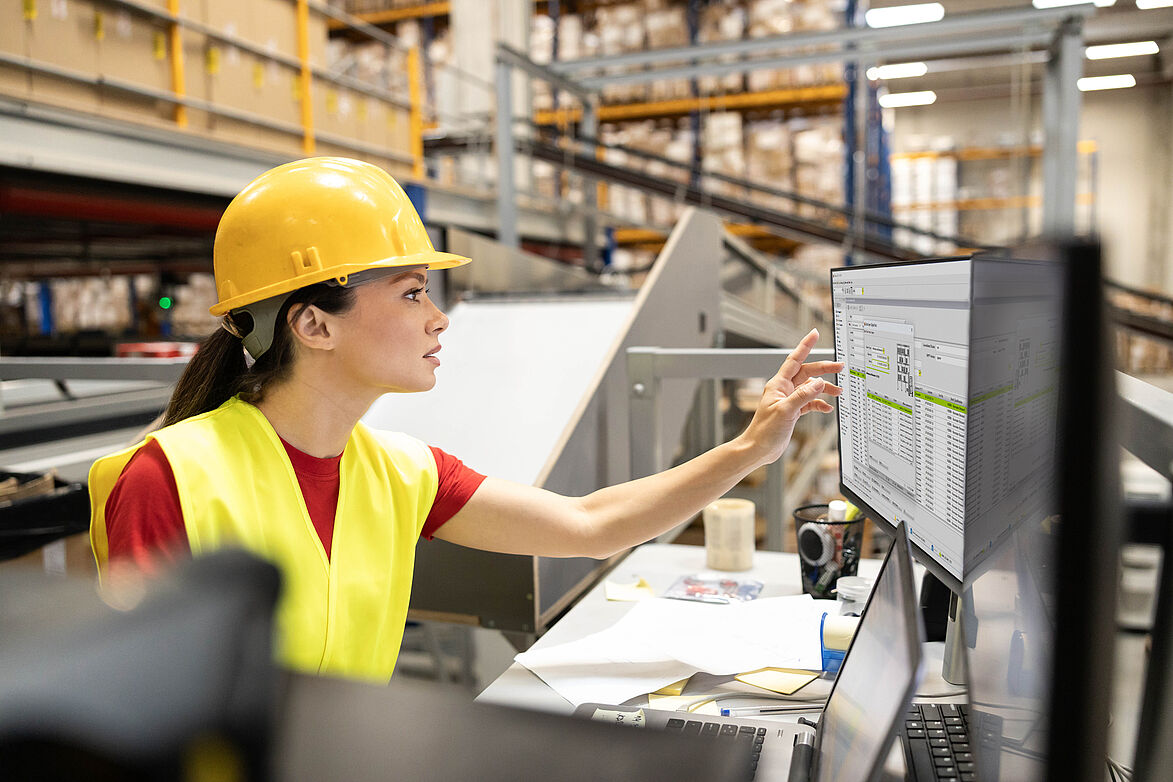The key success factors in logistics – efficiency, speed, and flexibility – require constant innovation, and technologies are sought to improve their performance. In this context, the digital twin is becoming increasingly important.
![[Translate to English:] PSIwms Digital Twin [Translate to English:] Software screenshot of PSIwms Digital Twin](/fileadmin/_processed_/5/4/csm_2025-Screen-PSIwms-Digitaler-Zwilling-EN_2aa6f1df0d.jpeg)
Visualizing complex processes, identifying bottlenecks at an early stage, exploiting optimization potential – the digital twin makes it all possible. It allows companies to run through various scenarios without risk and determine the expected impact of planned changes on the relevant KPIs. This makes it possible to identify the necessary action before a problem arises in the real world, making the digital twin one of the most advanced technologies for optimizing logistics processes.
What is a digital twin?
As futuristic as the term “digital twin” may sound, the concept is increasingly becoming a reality, especially in logistics. It refers to a specially developed simulator or virtual representation of a physical object or process that reflects all relevant characteristics in real time. In warehouse management, this means a digital replica of the warehouse – including warehouse structure, article distribution, movement data, technical resources, and logistical processes. What makes the digital twin special is its dynamism: it reacts to changes, adapts, and continuously maps the real environment.
With PSIwms AI, PSI has developed the first artificial intelligence-based platform that is directly connected to the PSIwms warehouse management system. The solution analyzes and optimizes WMS-supported logistics processes using a digital twin. This virtual test warehouse is connected to the WMS and represents the actual warehouse by reflecting all relevant processes and characteristics. This enables the testing of thousands of different warehouse operation scenarios flexibly, quickly, and cost-effectively. In this way, it is possible to test how the most important KPIs change when adjustments are made without actually intervening in the physical warehouse. For example, it is possible to check how additional warehouse automation affects efficiency or whether warehouse staff are able to cope with an upcoming sales peak.
Simulation in the digital twin makes it possible to generate training data, which is then used to train machine learning models. The models trained in this way are stored and managed in the PSIwms AI solution. This approach ensures the high quality of the solution in the long term, even with dynamic changes in the real warehouse environment, and contributes to continuous optimization.

Use case: AI in logistics
Artificial intelligence is the top trend in the WMS market and will become a cornerstone of modern logistics processes in the future. PSI already offers an AI platform that delivers measurable results in customer use. For example, the fashion company LPP was able to significantly optimize its intralogistics processes with the help of PSIwms AI. At six locations, the solution helps LPP to make a large part of its intralogistics more intelligent. Read more in the use case.
Practical application at LPP
The Polish fashion group LPP is already using PSIwms AI very successfully. The goal of the internationally active company is to meet constantly growing demand while maintaining high quality and short delivery times. This is to be achieved with the existing staff, without additional automation. LPP found the solution in PSIwms AI. With the help of the AI platform, it was possible to increase the efficiency of the picking process by 23 percent. LPP now uses PSIwms AI in all six of its fulfillment centers in Poland, Romania, and Slovakia, and is planning to further expand PSIwms with PSI. This will enable the fashion company to make a large part of its intralogistics more intelligent.

Report on the study AI in logistics
Explore the report to learn how artificial intelligence is being applied in warehouse logistics and the key areas where this emerging technology is making an impact. The study also reveals when intralogistics decision-makers plan to invest in AI and the challenges companies face during implementation.
Conclusion: The digital twin is more than just a trend
Those who use a digital twin in conjunction with artificial intelligence and a powerful warehouse management system are creating the intralogistics control center of the future. The PSIwms AI platform provides a blueprint for this, showing how warehouse processes can be holistically optimized in this way. Here, the digital twin makes warehouse processes visible, optimizable, and plannable before adjustments are made in real operation. Companies benefit from informed decisions, shorter distances, more efficient use of resources, and greater transparency. Against the backdrop of rapidly changing market conditions, more and more companies are turning to digital twins as the key to greater flexibility, transparency, and resilience in warehouse operations.

